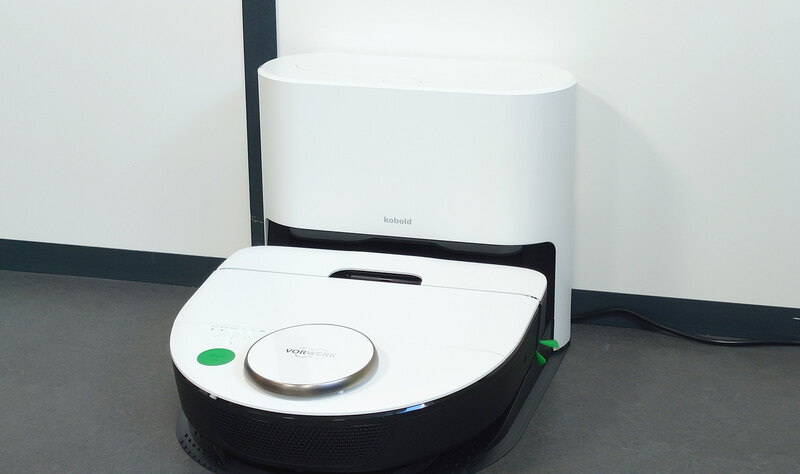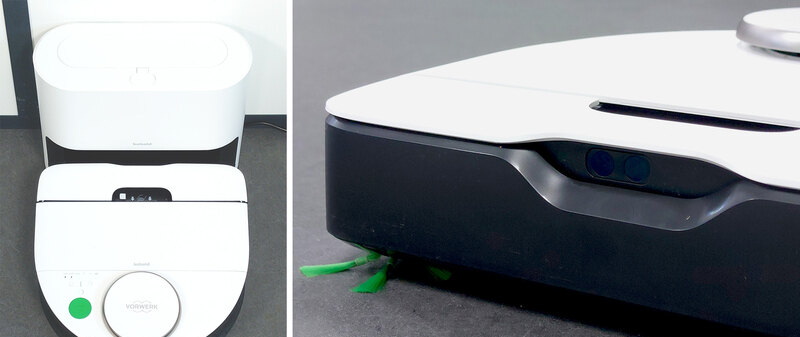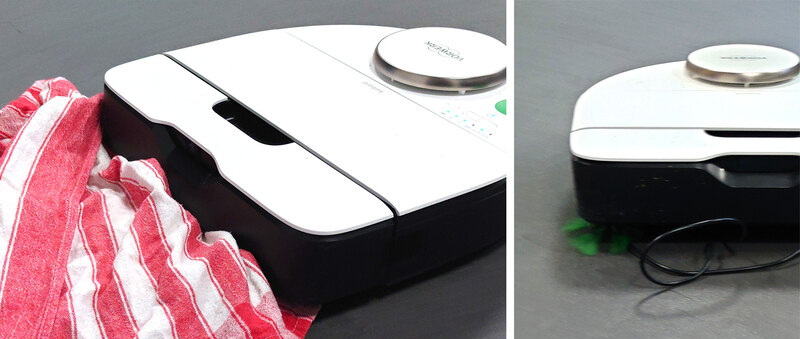Introduction to the Kobold VR7
Vorwerk, renowned for its Thermomix robot cooker, has set its sights on the robot vacuum cleaner market under the Kobold brand. This move aims to capitalize on the acquisition of Neato’s technology. The Kobold VR7 inherits American patents and technologies, offering new features not found in Neato models, such as the TOF sensor and the automatic emptying station. This station also doubles as a charger and can power the VK7 stick vacuum cleaner, creating a combination Vorwerk calls its “Dream Team.”

To enjoy a comprehensive floor maintenance solution, you’ll need both the Kobold VR7 and the VK7 stick vacuum since the VR7 focuses on vacuuming and lacks mopping capabilities. The pricing structure offers two options: one with the complete station and the other with a simplified charging station. The VR7 can be acquired with the former for €1,399 or the latter for €999.
Kobold VR7 Specifications:
- Cleaning Modes:
- Auto Mode
- Max Mode
- Navigation System:
- Laser rangefinder (LiDAR)
- TOF sensor for obstacle detection
- Design:
- D-shape design for efficient cleaning along walls
- A comprehensive control panel on the robot’s top
- Dimensions: 10.1 cm height
- Color: Predominantly white with green accents
- Collector and Emptying:
- Full-width collector access hatch
- Waste collector capacity: 480 ml
- Automatic emptying station with a charging function
- Station dust bag capacity: 2.2 liters
- Connectivity:
- MyKobold mobile app
- 2.4 GHz Wi-Fi connectivity
- Battery Life:
- Advertised: 60 minutes (Auto Mode)
- Real-world performance: Up to 1 hour and 23 minutes
- Noise Levels:
- Maximum noise level: 60 dB(A) at 1 meter distance
- Noise levels on hard floors: 58 dB(A)
- Noise levels on thicker carpets: 56 dB(A)
- Auto mode on hard floors: 53 dB(A)
- Additional Features:
- Virtual barriers for customized cleaning zones
- Room division through the app
- Multi-floor mapping with one map stored at a time
- Scheduled cleaning options
- Maintenance:
- HEPA filter requiring regular cleaning
- Routine sensor and brush maintenance without tools
- Compatibility with VK7 stick vacuum for comprehensive floor maintenance
User Convenience and Design
The VR7 exhibits a design reminiscent of Neato robots, complete with a laser rangefinder (LiDAR) and a full-width collector access hatch. The resemblance to Neato models is evident, but there are noteworthy additions.
The robot features Kobold’s signature colors – predominantly white with hints of green. It also incorporates a TOF sensor on the front, distinct from the LiDAR that rotates above the robot for mapping. The TOF sensor helps the robot navigate around small obstacles in its path. The robot maintains a reasonable height of 10.1 cm, fitting easily under furniture and around the house.
The top of the VR7 houses a comprehensive control panel. While it doesn’t provide access to all the robot’s features, it allows you to select a power level before cleaning. This power selection feature is rare in the current market, as most competitors offer a simple start button.

Thanks to its D-shape design, the VR7 incorporates a large roller on the bottom, enabling it to clean close to walls efficiently. It also includes a small side brush for areas that are less accessible. The waste collected during cleaning goes into a 480 ml collector, which is average in size, though smaller than what you’d find in Neato models (700 ml). Manual emptying should not be frequently required, thanks to the station’s ability to handle this task. The station employs a suction system assisted by a bag with a large 2.2-liter capacity, significantly reducing the need for manual emptying.
However, the station lacks a command interface for functions such as activating the automatic emptying. This is an omission since the VR7 boasts a detailed control panel.
The station’s compact and refined design differentiates it from bulkier options like the Deebot X2 Omni. Vorwerk offers the VR7 with a simplified charging station for those who value space-saving and discretion.
Connectivity and Mobile Application
The Kobold VR7 can be launched using its onboard controls, but it also comes with a mobile app called MyKobold. Connectivity occurs via 2.4 GHz Wi-Fi, and the app offers some features, although it doesn’t reach the full potential of modern robot vacuum apps.
The app’s map management is somewhat disorganized, allowing only one map to be stored at a time, which might be inconvenient for multi-story homes. Room division is left to the user’s discretion if they wish to clean specific areas separately. The app also offers virtual barriers for more control. For spot cleaning, you need to create a room within a room using the map editor. Cleaning settings include cleaning the entire house or specific rooms with two suction power levels and an Auto mode for carpet detection.
The app lacks real-time tracking of the robot’s movements, so you must wait until the cleaning cycle finishes to check its path. Coverage maps appear in the history section, displaying the cleaned areas. Given the VR7’s dedicated sensor for detecting objects, some users might have expected obstacle information. MyKobold supports scheduled cleanings for different days of the week but remains relatively simple in terms of functionality.
Maintenance and Cleaning Performance
The Kobold VR7 requires minimal daily maintenance, and the absence of a mop simplifies this process compared to more versatile robots. However, a few aspects deserve attention.
The automatic collector emptying system works effectively, but sometimes, the robot loses some debris when returning to the station, scattering it on the floor. Additionally, the HEPA filter requires regular cleaning, as it tends to accumulate dirt. The absence of a filter-cleaning tool is a missed opportunity, similar to what Neato provided.

Replacing the station’s dust bag, while hygienic, is somewhat impractical due to the rear access. Removing the station from the wall, especially when the VK7 stick vacuum is attached, can be cumbersome. At €20 for a pack of six bags from Kobold, this presents an additional cost. It would have been more convenient if the same bags used for the VK7 broom were compatible, streamlining orders.
Other routine tasks, such as sensor and brush maintenance, are straightforward and don’t pose significant challenges. Accessibility without the need for tools is a practical aspect.
Navigation System
Equipped with a laser rangefinder (LiDAR) on top and a TOF sensor at the front, the Kobold VR7 maps the home meticulously and detects minor obstacles to navigate around them. It also features a standard set of sensors, particularly for vacuuming.
In practice, the robot performs well in tidy environments. Although it’s not perfect, its D-shape design allows it to clean corners effectively. The brush is less advanced than Neato models, sometimes leaving a small debris strip. However, the VR7 approaches walls closely before reversing and turning, making it a comprehensive cleaner.
The robot starts by circumnavigating the rooms (or predefined areas within large rooms) and then crosses them. It may occasionally make early U-turns, leaving behind some uncleaned areas, usually small ones. Despite the TOF sensor, the VR7 often fails to detect small obstacles, including textiles, containers, or cables.
Occasionally, the robot may get stuck or struggle with the legs of certain types of furniture. It doesn’t attempt to move curtains that reach the floor and instead avoids them by cleaning around. Users should be cautious about moving large furniture or objects, as the robot might not return to familiar paths. Resetting the map might be necessary to regain its orientation. In a cluttered environment, the VR7 adapts well after minor adjustments and generally avoids getting lost. This contrasts with some competitors, such as iRobot’s Roomba J7+.

Notably, the Kobold VR7 excelled in our navigation test, collecting a significant portion of debris at a rate of 76%.
Suction Performance
The Kobold VR7 comes close to the top-performing robots regarding suction power but faces a vexing issue. Debris enters the collector through two suction ports: the primary one at the front of the motorized brush and a narrower one slightly behind it. Unfortunately, debris entering the second port tends to get stuck, and occasionally, they fall in front of the station when the robot docks.
Despite these concerns, the VR7 achieved commendable results in our tests. It captured up to 91% of debris on hard floors in Max mode. In Auto mode, where the motor operates at a lower power level on hard floors, it still collected 81% of debris before returning to full power on carpets. The Auto and Max modes produced similar results on fine and long-pile carpets, with debris capture rates ranging from 91% to 93% and 83% to 84%, respectively.
Battery Life
The Kobold VR7 boasts reliable battery life performance, making it suitable for efficiently cleaning various spaces. While it is advertised with 60 minutes of autonomy in its standard Auto mode, it often exceeds this duration in real-world conditions. During testing, the VR7 impressively operated for 1 hour and 23 minutes before returning to its charging station for a recharge. This extended runtime allows the robot to clean larger areas without frequent interruptions.
One notable aspect of the VR7’s battery management is its conservative approach. The robot typically reserves approximately 25% of its battery capacity to ensure it has enough power to return to its charging station autonomously. This prudent approach prevents the robot from getting stranded during a cleaning cycle, ensuring it can always find its way back to recharge.
Overall, the Kobold VR7’s battery life is commendable, providing users with extended cleaning cycles and the convenience of minimal manual intervention for recharging.
Noise Levels
One of the standout features of the Kobold VR7 is its relatively low noise levels during operation. Even when the robot runs at its maximum power setting, it emits minimal noise, reaching no more than 60 dB(A) when measured from a distance of 1 meter.

In practical terms, the VR7 is a quiet vacuum cleaner, and its operation is unlikely to disrupt daily activities or be a significant source of noise pollution in the home. On hard floors, the robot was measured at 58 dB(A); on thicker carpets, the noise level remained at 56 dB(A). In its Auto mode on hard floors, the robot’s noise emissions dropped even further to 53 dB(A).
The automatic emptying process, while slightly noisier, still maintains an acceptable noise level, reaching up to 68 dB(A). However, this phase is relatively brief, lasting approximately 25 seconds.
Overall, the Kobold VR7’s noise levels are one of its notable strengths, making it an unobtrusive addition to the household and ensuring a quieter cleaning experience.
Conclusion
The Kobold VR7 is a versatile vacuum for all floor types, adapting well to various environments. However, it struggles with detecting small obstacles, and there’s room for improvement in waste disposal. The automatic emptying feature, while effective, occasionally results in scattered debris. Regular maintenance is crucial, particularly for the HEPA filter.
Despite its strengths, the VR7 lacks mopping capabilities, which may be a drawback for some users. Overall, it offers a robust vacuuming solution, but users should be prepared for some manual maintenance and aware of obstacle detection limitations.
Advantages:
- Advanced Suction Performance: The Kobold VR7 boasts powerful suction capabilities, efficiently cleaning various floor types. It excels in capturing debris on hard floors and carpets, offering commendable results in both Auto and Max modes.
- Extended Battery Life: With reliable battery life, the VR7 operates for an impressive duration, often exceeding the advertised 60 minutes in real-world conditions. The conservative battery management ensures the robot reserves ample power to return to its charging station autonomously, minimizing manual interventions.
- Low Noise Levels: The VR7 stands out for its low noise emissions during operation. Even at its maximum power setting, the robot emits minimal noise, providing a quiet cleaning experience that is unlikely to disrupt daily activities.
Disadvantages:
- Obstacle Detection Issues: The VR7 struggles with detecting small obstacles, occasionally leading to collisions or failure to navigate around minor hindrances. This limitation may result in the robot getting stuck or leaving behind uncleaned areas.
- Debris Scattering During Emptying: While the automatic emptying system is effective, there are instances where the VR7 loses some debris when returning to the station, scattering them on the floor. This could be a potential inconvenience, requiring additional manual cleaning.
- Limited Waste Disposal Convenience: Replacing the dust bag in the station, while hygienic, can be impractical due to the rear access. Removing the station from the wall, especially with the VK7 stick vacuum attached, may be cumbersome. Additionally, the absence of a filter-cleaning tool is a missed opportunity for added convenience.





